Test Design Techniques - STATE BASED TESTING
Test Design Techniques - STATE BASED TESTING
-Test note of “Essential Software Test Design”
2015-08-19
Content:
13.1 The Model
13.1.1 The ATM Machine
13.2 Creating Base Test Cases
13.2.1 Ways of Covering the Graph
13.2.2 Coverage According to Chow
13.2.3 Creating Test Cases
13.2.4 Transition Pairs
13.2.4.1 Expanding the Table by one Column
13.2.4.2 Creating a Dual Graph
13.2.5 Transition Triples and More
A STATE GRAPH, or state transition testing, is a model-based technique for compiling test cases. It works with event-driven systems, often in real time, and is common in areas like digital technology and electronics in hardware.
13.1 The Model
2 type:
- Mealy Graphs, where the state is represented by nodes and the links between the nodes represent transitions.
- Moore Graphs, where the events are represented by nodes.
Mealy Graphs are simpler to work with since they:
- More closely resemble what happens on their actual implementation
- Have fewer states, and since;
- The states are stable
- You can repeat events more easily without the graph becoming more complex
We call the states nodes, and call connections between the nodes links.
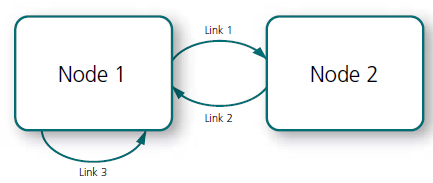
Figure 13.1: State Graphs consist of nodes and links. An arc is also called a transition. Links which start and end at the same node denote that an event does not lead to a transition, but it still undergoes some form of process.
Steps compile a graph:
- Compile the different states an object can find itself in
- Compile the transitions between the different states
- Identify the events which cause a transition to occur
- Define what happens during each transition
13.1.1 The ATM Machine
1. The different states are as follows:
a) Standby – nobody has inserted a card into the machine yet
b) Card inserted, request for PIN
c) PIN accepted – waiting for transaction
2. Draw arrows for the transitions according to the function descriptions
3. Events causing transition are:
a) Insert card
b) Enter correct PIN
c) Enter incorrect PIN
d) Enter correct transaction
e) Enter incorrect transaction
f) Choose to abort
4. What is carried out during transition is:
a) Request new PIN
b) Request new card
c) Request transaction
d) Eject money, card and receipt (execute transaction)
You have now created the picture below and the difficult work is complete.
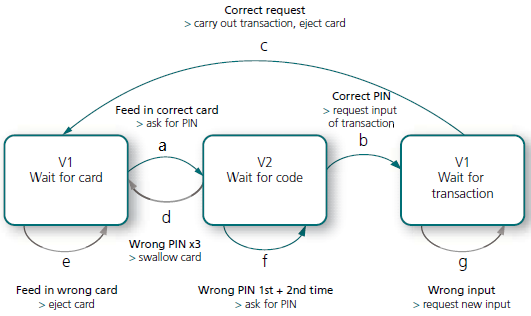
Figure 13.2: Very simple state graph for an ATM. In reality, there are more states and events that are interesting to test and should be present in a complete graph.
13.2 Creating Base Test Cases
13.2.1 Ways of Covering the Graph
There are a number of variants of how to fill in the graph you have drawn up, besides the one described above. Some of them are:
- Typical routes. The most credible combinations
- The travelling salesman’s route. All different states in one test case.
- The Chinese Postman’s route. All transitions in the same test case, if there is that possibility.
- Risk-based. Routes where you think that a particular combination of transitions can cause problems.
- All routes a certain length. From shortest to longest until you have covered all combinations. This is suited to automation, since it repeats many combinations and takes a long time to carry out.
- All ways of leaving a state. For example, via a menu, function key, hot key, button and so on.
- All events which should not produce a transition. Verifies the system’s robustness.
13.2.2 Coverage According to Chow
One method is to cover, firstly, all transitions, then all transitions pairs, triples etc. This was originally presented by Chow.
When you generate the test cases, there are different levels in the degree of coverage. Covering every individual transition is often called Chow’s 0-switch coverage. This can be visualized in a simple table.
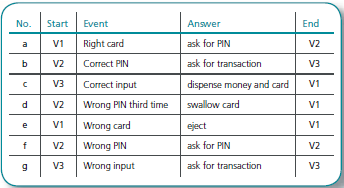
Figure 13.3: Table of the different transitions in the state graph for the ATM. The simplest form of test coverage is to test all the rows in the table.
13.2.3 Creating Test Cases
The next step is to generate the test cases and, in parallel with this, mark off the transitions you are covering.
Test Case 1 (transitions a, f, b, g and c are covered)
- Insert right card (a)
- Enter wrong PIN (f)
- Enter correct PIN (b)
- Enter wrong input (g)
- Enter correct input (c)
- Take eject money, card and receipt
Test Case 2 (transition e is covered)
- Insert wrong card (e)
- Take ejected card
Test Case 3 (transition a, f, d is covered)
- Insert right card (a)
- Enter wrong code (f)
- Enter wrong code (f)
- Enter wrong code (d)
- Card is swallowed and you are back at the starting point
13.2.4 Transition Pairs
In order to achieve better coverage, you can use what we call transition pairs, involving two transitions in a row. The idea is that the result of an event in the system depends on what has happened in the preceding event. Sometimes, you will see the term 1-switch coverage.
13.2.4.1 Expanding the Table by one Column
There are two different ways of solving this, the first being to start with the first table and adding one additional column.
Analysis of our ATM produces the following 16 links:
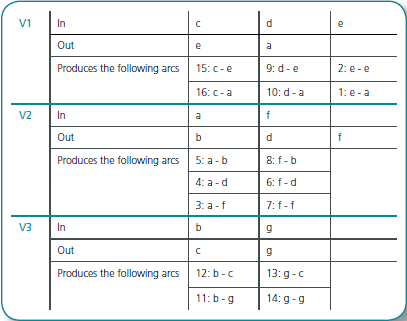
Figure 13.5: Table showing development of transition pairs for the state graph ATM. We obtain all pairs by combining all routes into a node with all routes out of it. Even self-transactions, where we stay on the same node after transition, are counted.
The consolidated table is below, but columns showing event/answer have been taken out in order to simplify the table
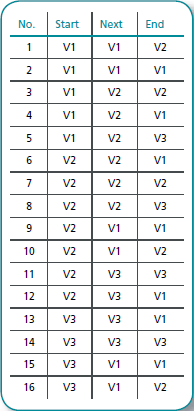
Figure 13.6: Consolidated table of transition pairs for ATM state graph. A more accurate form of coverage is to test all combinations of two transitions. Obviously, this requires more test cases.
13.2.4.2 Creating a Dual Graph
You can also generate a dual graph, where the transitions represented earlier by links are substituted by nodes: in other words, a Moore graph. This way of testing all paired transitions is called the de Bruijn algorithm. To generate a dual graph, you do the following:
- Generate a graph where the links in the original have been changed to nodes.
- Everywhere in the original graph where arc 1 comes into a node, and arc 2 goes out of it, draw an arc between node 1 and node 2. Every arc will now represent a transition pair.
- Cover all links now with test cases.

Figure 13.7: Original and dual graph for the ATM. An alternative to developing the table of transition pairs is to create a Moore graph, where each transition represents a transition pair in the Mealy graph.
13.2.5 Transition Triples and More
You can proceed to more stringent requirements by setting up transition triples and quadruples, by adding another column in the table of transition pairs. The problem is that the number of test cases grows very quickly, so it is often difficult to test all of the pairs without automating the tests. It is common to use at least transition pairs and, if you find many defects, to press on, with more advanced tests in certain areas.
Test Design Techniques - STATE BASED TESTING的更多相关文章
- TEST DESIGN TECHNIQUES: AN OVERVIEW
TEST DESIGN TECHNIQUES: AN OVERVIEW -Test note of “Essential Software Test Design” 2015-11-16 目录: 7. ...
- Spock - Document -04- Interaction Based Testing
Interaction Based Testing Peter Niederwieser, The Spock Framework TeamVersion 1.1 Interaction-based ...
- paper:synthesizable finite state machine design techniques using the new systemverilog 3.0 enhancements 之 FSM Coding Goals
1.the fsm coding style should be easily modifiable to change state encoding and FSM styles. FSM 的的 状 ...
- paper:synthesizable finit state machine design techniques using the new systemverilog 3.0 enhancements之onehot coding styles(index-parameter style with registered outputs)
case语句中,对于state/next 矢量仅仅做了1-bit比较. parameter 值不是表示FSM的状态编码,而是表示state/next变量的索引.
- paper:synthesizable finite state machine design techniques using the new systemverilog 3.0 enhancements 之 standard verilog FSM conding styles(二段式)
1.Two always block style with combinational outputs(Good Style) 对应的代码如下: 2段式总结: (1)the combinational ...
- paper:synthesizable finit state machine design techniques using the new systemverilog 3.0 enhancements之fsm summary
主要是1.不要用1段式写FSM 2.不要用状态编码写one-hot FSM ,要用索引编码写one-hot FSM.
- paper:synthesizable finit state machine design techniques using the new systemverilog 3.0 enhancements之全0/1/z/x的SV写法
- paper:synthesizable finit state machine design techniques using the new systemverilog 3.0 enhancements之enhanced coding styles
1.ANSI style 的代码比较紧凑. 下面规范推荐,比较好. 下面是带有parameter的module header的完整规范 一般1bit ,大家都是wire signal1 = gen_s ...
- paper:synthesizable finit state machine design techniques using the new systemverilog 3.0 enhancements之fsm1各种style的timing/area比较
整体说,一般还是用2段式,再加上output encodecd/default -X技巧.
随机推荐
- 不一样的go语言-athens私仓安装
前言 本系列文章曾多次提及go的依赖管理,提到了私仓,构件系统等概念,也曾提及当前流行的go构件系统,如athens,jfrog artifactory.鉴于jfrog的收费特性,本文只选择ath ...
- Java 并发编程整体介绍 | 内含超多干货
前段时间一直在学习多线程相关的知识,目前也算有了一个整体的认识,今天呢,主要从整体介绍一下,只谈造火箭,拧螺丝这种细节还需要自己深究. 首先是操作系统级别对于多线程的支持,由 CPU 的多级缓存.缓存 ...
- 运行程序,解读this指向---case1
一.分析代码执行结果 var length = 10; function fn() { console.log(this.length); } var obj = { length: 5, metho ...
- DataGridView控件-[引用]
DataGridView控件 DataGridView是用于Windows Froms 2.0的新网格控件.它可以取代先前版本中DataGrid控件,它易于使用并高度可定制,支持很多我们的用户需要的特 ...
- BZOJ.2002.Bounce 弹飞绵羊(LCT)
题目链接 从一个点只能往后跳,即后继状态只有一个,那么拿nxt[x]做fa[x]啊!这样就成了一棵树,从每个点开始的答案是它到所在树的根节点的距离. nxt[]的更改即动态修改树边,用LCT即可. 这 ...
- 解决boostrap中,iframe渲染下,苹果手机横向无法显示剩余内容问题
描述: 问题解决了,采用的手势拖动显示剩余内容,并不是有了横向滚动条 在head标签中加入 <head> <meta charset="utf-8"> &l ...
- Android HandlerThread 源代码分析
HandlerThread 简单介绍: 我们知道Thread线程是一次性消费品,当Thread线程运行完一个耗时的任务之后.线程就会被自己主动销毁了.假设此时我又有一 个耗时任务须要运行,我们不得不又 ...
- Linux 10字符串命令病毒的处理记录
刚上线的测试服务器不停的向外发包,且CPU持续100%,远程登录后查看发现有一长度为10的随机字符串进程,kill掉,会重新生成另外长度为10的字符串进程.删除文件也会重复生成,非常痛苦.查阅cron ...
- ubuntu 安装JDK1.6(jdk-6u45-linux-x64.bin)
ubuntu 安装JDK1.6 首先在官网下载JKD1.6 linux的版本:http://www.oracle.com/technetwork/java/javasebusiness/downloa ...
- Android数据库大批量数据插入优化
对比在android中批量插入数据的3中方式对比(各插入1W条数据所花费的时间): 1. 一个一个插入 public static boolean insert(SQLiteOpenHelper op ...
